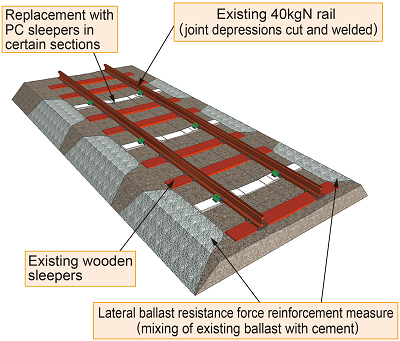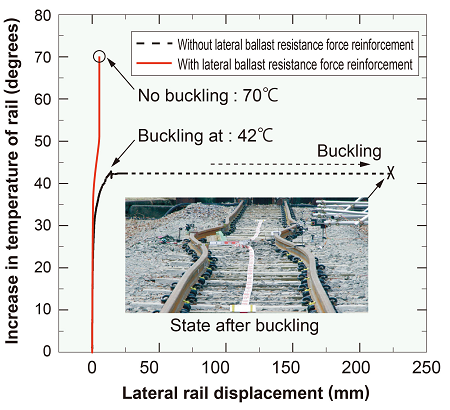16. Low-cost continuous welded rail track structure suitable for regional railways
Rail joints, which are a weakness in tracks on regional railways are a significant problem in terms of maintenance, given their high number, and so a low-cost effective means to reinforce track structures is essential.
It is thought that one potential, effective method to solve this problem in particular, would be to develop a low-cost method to introduce continuous welded rails, which would remove rail joints and significantly reduce maintenance costs. However, existing continuous welded rail track structures are designed for trunk lines, and would be difficult to introduce on regional railways given the high implementation cost.
In the proposed track structure, some wooden sleepers are replaced with PC sleepers, while the soil/ballast mix is kept as it is, and joint depressions are sectioned off and welded.
In order to maintain the lateral stability obtained through analysis the lateral ballast resistance force of 14.7kN required in certain sleepers is guaranteed by adding cement to the ballast through stabilizing reinforcement (Fig. 1).
The developed continuous welded rail track structure was used to build a full size track model, and rail heating tests were conducted.
The results confirmed that after the lateral ballast resistance force reinforcement work was done, no buckling occurred when the temperature of the rail was increased by 70 C (Fig. 2).
In addition, when using RTRI’s test line installations, it was confirmed that lateral ballast resistance force track reinforcement work could be carried out for less than 20 000 JPY (approximately 165 Euro or 183 USD) per meter of track.
As a result, the new continuous welded rail track structure can be introduced for less than half the current cost.
Other Contents
- 12. Method for monitoring state of driving devices using vibration analysis and machine learning
- 13. Wheel flange-wear reducing wheel-tread friction block
- 14. High-strength bolted friction joints for existing weathering steel bridges
- 15. Bridge pier stability monitoring method using microtremor data
- 16. Low-cost continuous welded rail track structure suitable for regional railways
- 17. Track stiffness inspection method using portable track stiffness measuring device (RFWD)
- 18. Device to determine fouling of structural clearance gauge using on-board 3D laser scanner
- 12. Method for monitoring state of driving devices using vibration analysis and machine learning
- 13. Wheel flange-wear reducing wheel-tread friction block
- 14. High-strength bolted friction joints for existing weathering steel bridges
- 15. Bridge pier stability monitoring method using microtremor data
- 16. Low-cost continuous welded rail track structure suitable for regional railways
- 17. Track stiffness inspection method using portable track stiffness measuring device (RFWD)
- 18. Device to determine fouling of structural clearance gauge using on-board 3D laser scanner


